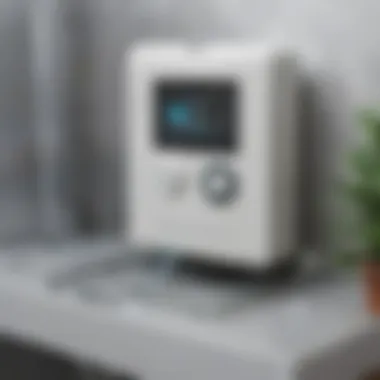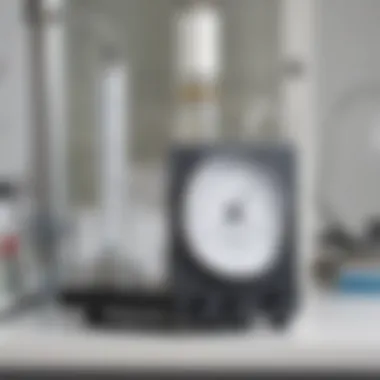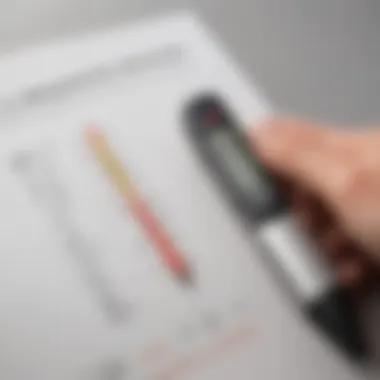Unlocking the Secrets of Humidity Measurement: A Detailed Exploration


Science Fun Facts
Humidity measurement plays a crucial role in various industries and day-to-day activities. It is vital to understand the level of moisture in the air for applications such as agriculture, meteorology, and HVAC systems. Did you know that the concept of humidity dates back to ancient times when Greek philosophers first pondered the nature of air and water?
Discover the Wonders of Science
When we talk about humidity, we are exploring a fundamental aspect of the atmosphere's composition. Dive into educational content on how humidity affects cloud formation, precipitation, and overall weather patterns. You can find fascinating videos and animations explaining the science behind humidity and its impact on our environment.
Science Quiz Time
Test your knowledge about humidity with interactive quizzes that challenge your understanding of dew point, relative humidity, and moisture content. Engage in brain teasers that make you think critically about the role of humidity in our daily lives. Learning through gamification can make complex scientific concepts more enjoyable and accessible.
Science Experiment Showcase
Embark on fun experiments to understand humidity measurements better. Follow step-by-step instructions to create your homemade hygrometer and observe how humidity affects its readings. Ensure safety by following provided tips and precautions to conduct these experiments responsibly.
Introduction
Humidity, an often overlooked element of our surroundings, plays a fundamental role in various aspects of daily life. In this comprehensive guide on how to measure humidity, we will delve into the intricacies of this seemingly elusive concept. From its effects on health and industrial processes to its significance in different environments, understanding humidity levels is crucial for optimizing comfort and productivity.
Importance of Humidity Measurement
Effects of High and Low Humidity
Humidity levels significantly impact our well-being and the environments we inhabit. High humidity can lead to a myriad of challenges, including mold growth, respiratory issues, and discomfort. Conversely, low humidity levels can cause skin dryness, static electricity, and potential damage to wooden furniture. Recognizing these effects is paramount in maintaining a healthy and balanced atmosphere. While high humidity fosters mold growth, low humidity can result in brittle hair and parched skin. Understanding the effects of both extremes equips us with the knowledge needed to regulate indoor climates effectively.
Significance in Different Environments
The importance of humidity measurement extends beyond individual well-being to encompass diverse settings. In industrial facilities, controlling humidity is critical for ensuring product quality and workforce comfort. Likewise, in residential spaces, maintaining optimal humidity levels is essential for preserving furniture, preventing mold, and supporting overall health. The significance of humidity measurement lies in its adaptability to various contexts, making it a valuable tool for enhancing living conditions and operational efficiency.
Purpose of Humidity Measurement
Health Considerations
Humidity measurement directly impacts human health, influencing respiratory function, skin moisture, and general comfort levels. By monitoring humidity levels, individuals can mitigate potential health risks associated with excessive moisture or dryness. Maintaining optimal humidity levels is particularly crucial for sensitive individuals, such as those with respiratory conditions or skin sensitivities. Understanding the health implications of humidity empowers individuals to create environments that promote well-being and vitality.
Industrial Applications


In industrial settings, humidity measurement is indispensable for ensuring product integrity, process efficiency, and worker safety. From pharmaceutical manufacturing to food processing, controlling humidity levels is integral to quality assurance and regulatory compliance. By precisely monitoring humidity, industries can mitigate the risk of corrosion, contamination, and product spoilage. The diverse applications of humidity measurement in industrial contexts underline its pivotal role in sustaining operational excellence and product reliability.
Methods of Humidity Measurement
Humidity measurement is a critical aspect of various industries and everyday life, as it provides insights into moisture levels in different environments. The methods employed for measuring humidity play a pivotal role in ensuring accuracy and reliability in readings. By utilizing advanced techniques and tools, such as hygrometers and psychrometers, professionals can obtain precise humidity data essential for decision-making processes.
Hygrometers
Hygrometers are instrumental devices designed to measure humidity levels accurately. They are commonly used in various settings, including industrial facilities, laboratories, and meteorological stations. By employing hygrometers, individuals can monitor and regulate humidity levels efficiently, contributing to optimal working conditions and product quality.
Mechanical Hygrometers
One of the primary types of hygrometers is mechanical hygrometers, known for their robust design and reliable performance. These instruments operate based on mechanical principles, utilizing elements such as hair or paper membranes to indicate relative humidity levels.
- Mechanial hygrometers provide a cost-effective solution for humidity measurement, offering high accuracy and durability in harsh conditions.
Electronic Hygrometers
On the other hand, electronic hygrometers leverage advanced technology to deliver real-time humidity readings with precision. These devices use sensors and digital displays to convey humidity data swiftly and accurately.
- Electronic hygrometers offer quick and easy-to-read results, making them a popular choice for applications requiring instant humidity monitoring.
Psychrometers
Psychrometers are specialized instruments used for measuring the moisture content in the air. They play a crucial role in analyzing air properties and determining humidity levels accurately.
Wet-bulb Psychrometers
Wet-bulb psychrometers measure humidity by comparing the cooling effect of water evaporation on a wet bulb with that of a dry bulb's temperature. This method provides valuable insights into humidity variations and helps in predicting weather patterns.
- Wet-bulb psychrometers are widely used in meteorology and agricultural settings for assessing moisture content and potential rainfall.
Dry-bulb Psychrometers
In contrast, dry-bulb psychrometers focus solely on the air's dry bulb temperature to determine relative humidity. This straightforward approach aids in quick humidity assessments without additional variables.
- Dry-bulb psychrometers are favored for their simplicity and efficiency in day-to-day humidity measurements.


Dew Point Measurement
Dew point measurement involves determining the temperature at which air reaches saturation and moisture starts to condense. This critical parameter is fundamental in understanding humidity levels and potential condensation issues in various environments.
- Calculation methods for dew point allow for accurate humidity assessment, helping in preventing mold growth and preserving sensitive materials.
- Applications of dew point measurement extend to industries like food storage and pharmaceutical manufacturing, where maintaining specific humidity levels is imperative for product quality and safety.
Tools for Humidity Measurement
Humidity measurement plays a crucial role in various industries and environments, ensuring optimal conditions for processes and human comfort. In this article, we will delve deep into the significance of tools used for humidity measurement. These tools, such as thermo-hygrometers and chilled mirror hygrometers, provide essential data for maintaining ideal humidity levels. By understanding the different types of tools and their applications, readers can grasp the intricacies of humidity measurement and its impact on quality of life and productivity.
Thermo-Hygrometers
Thermo-hygrometers are fundamental instruments for measuring both temperature and humidity levels with high precision. Within the realm of thermo-hygrometers lie two main categories: digital thermo-hygrometers and analog thermo-hygrometers. These instruments offer unique characteristics that cater to varying needs in humidity measurement.
Digital Thermo-Hygrometers
Digital thermo-hygrometers are modern devices equipped with digital sensors for accurate real-time readings of temperature and humidity. Their user-friendly interfaces and compact designs make them popular choices for both professional and personal use. The distinct advantage of digital thermo-hygrometers lies in their instant data display and ease of calibration. However, their reliance on batteries and electronic components may pose limitations in certain environments.
Analog Thermo-Hygrometers
In contrast, analog thermo-hygrometers provide a traditional yet reliable method of measuring humidity levels. Their simplistic design and mechanical operation make them durable options for long-term use. The unique feature of analog thermo-hygrometers is their independence from power sources, ensuring continuous functionality without battery replacements or electrical issues. While analog thermo-hygrometers offer a classic appeal, they may require periodic adjustment to maintain accuracy.
Chilled Mirror Hygrometers
Chilled mirror hygrometers operate on the principle of condensation to determine humidity levels accurately. This mechanism involves cooling a mirror surface until dew forms, allowing for precise humidity measurements. The application of chilled mirror hygrometers proves invaluable in industries where moisture control is critical for processes and product quality.
Principle of Operation
The principle of operation for chilled mirror hygrometers revolves around the concept of dew point temperature. By monitoring the temperature at which moisture condenses on the mirror surface, these hygrometers calculate the dew point, providing a direct indicator of relative humidity. This method ensures highly accurate humidity readings, making chilled mirror hygrometers indispensable tools in calibration and sensitive environmental conditions.
Advantages and Limitations
The primary advantage of chilled mirror hygrometers lies in their unparalleled accuracy and reliability in measuring humidity. Their direct measurement approach avoids calibration drift and sensor inaccuracies, guaranteeing precise results. However, the chilled mirror technique may exhibit limitations in terms of response time and cost, making it more suitable for stationary or controlled settings where accuracy is paramount.
Calibration and Maintenance
Calibration and Maintenance play a crucial role in ensuring the accuracy and reliability of humidity measurement devices, making them indispensable aspects of this comprehensive guide. Without proper calibration, measurements may not reflect the true humidity levels, leading to potential errors in various applications. Regular maintenance is equally vital to prevent deterioration of equipment and guarantee consistent performance over time.


Calibration Procedures
Frequency of Calibration
Understanding the Frequency of Calibration is paramount in maintaining the precision of humidity measurement instruments. By determining how often a device needs calibration, users can uphold accuracy and enhance the credibility of recorded data. The Frequency of Calibration directly influences the device's ability to provide reliable measurements, making it imperative for users, especially in critical sectors like manufacturing and climate monitoring. Concerning the Frequency of Calibration, the key aspect lies in setting intervals based on usage patterns, environmental conditions, and device specifications. A well-defined calibration schedule ensures that the instrument functions optimally, minimizing the risk of inaccurate readings. Although frequency may vary depending on the instrument type and industry standards, adherence to a consistent calibration schedule remains a popular choice for reliability and trustworthiness in humidity measurement.
Methods for Accuracy
Exploring Methods for Accuracy in calibration procedures sheds light on the techniques employed to calibrate humidity measurement devices effectively. Each method carries distinct advantages and disadvantages, influencing the overall quality and precision of measurements. By choosing appropriate calibration methods, users can mitigate errors and maintain the integrity of collected data. When considering Methods for Accuracy, the emphasis lies on selecting the most suitable approach based on device type, intended application, and desired level of accuracy. Certain methods may offer higher precision but require specialized equipment or expertise, while others provide broader compatibility with different instrument models. Understanding the unique features of each calibration method enables users to optimize the accuracy of humidity measurements, meeting the specific requirements of their applications effortlessly.
Maintenance Practices
Cleaning Instructions
Incorporating Cleaning Instructions as part of maintenance practices ensures the longevity and functionality of humidity measurement devices. Proper cleaning protocols help prevent dust accumulation, residue buildup, and contamination, which could compromise measurement accuracy. By following recommended cleaning procedures, users can sustain the performance and longevity of their instruments. Regarding Cleaning Instructions, the key characteristic involves using gentle cleaning agents, non-abrasive materials, and suitable techniques to avoid damage or misalignment of sensitive components. Regular cleaning intervals, based on usage frequency and environmental exposure, contribute to the consistent operation and reliability of the instrument. While cleaning enhances device performance, it is essential to be mindful of potential drawbacks, such as the risk of altering calibration settings or causing mechanical issues.
Storage Guidelines
Understanding Storage Guidelines is essential for preserving the integrity and functionality of humidity measurement devices when not in use. Proper storage practices shield instruments from environmental hazards, moisture intrusion, and mechanical damage, prolonging their lifespan and ensuring accurate readings. Adhering to recommended storage conditions safeguards the instrument's performance during periods of non-usage. When it comes to Storage Guidelines, the key characteristic revolves around maintaining optimal temperature and humidity levels within designated storage areas. Avoiding direct sunlight, extreme temperatures, and high humidity environments safeguards the instrument from potential degradation and malfunctions. While adhering to storage guidelines is beneficial for device longevity, users must also be cautious of over-structuring storage conditions, which may create logistical challenges or excessive precautions.
Applications of Humidity Measurement
Humidity measurement plays a crucial role in various sectors, including meteorology and industrial processes. By accurately assessing humidity levels, professionals can make informed decisions that impact weather forecasting, climate studies, manufacturing, and storage practices. The ability to monitor and control humidity is vital for ensuring product quality, environmental conditions, and overall efficiency in operations.
Meteorology
Weather Forecasting
Weather forecasting relies heavily on precise humidity measurements to predict atmospheric conditions accurately. By understanding the moisture content in the air, meteorologists can anticipate weather patterns, precipitation, and temperature changes. The data obtained from humidity measurements contribute significantly to forecasting models, allowing for more reliable and insightful weather predictions. However, limitations exist in predicting extreme weather events, where sudden shifts in humidity levels can influence forecast accuracy.
Climate Studies
In climate studies, humidity measurement aids in analyzing long-term weather patterns and trends. By examining humidity levels over extended periods, researchers can identify climate fluctuations, assess the impact of global warming, and study biodiversity changes. The data gathered from humidity measurements provide critical insights into climate change phenomena, enabling scientists to develop strategies for adapting to environmental shifts. Despite its value in climate research, humidity measurement may face challenges in accurately capturing microclimate variations, affecting the precision of long-term climate projections.
Industrial Processes
Manufacturing
Humidity measurement holds significance in manufacturing processes for maintaining optimal production conditions. Controlling humidity levels in manufacturing facilities is essential for preserving raw materials, ensuring product quality, and enhancing production efficiency. By monitoring and adjusting humidity levels, manufacturers can prevent material degradation, minimize equipment corrosion, and optimize manufacturing workflows. However, challenges may arise in regulating humidity within large industrial spaces, where airflow and ventilation systems impact humidity distribution.
Storage and Preservation
In storage and preservation applications, humidity measurement is critical for preserving perishable goods, preventing mold growth, and maintaining inventory integrity. By monitoring humidity levels in storage facilities, businesses can extend the shelf life of products, reduce spoilage risks, and uphold food safety standards. The data obtained from humidity sensors aid in creating optimal storage conditions, preventing moisture-related damage, and enhancing product preservation methods. Nonetheless, variations in humidity levels within storage environments can pose challenges in uniformly controlling moisture content, impacting the effectiveness of preservation efforts.







